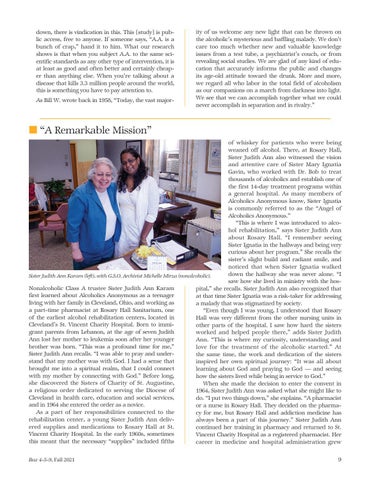down, there is vindication in this. This [study] is public access, free to anyone. If someone says, “A.A. is a bunch of crap,” hand it to him. What our research shows is that when you subject A.A. to the same scientific standards as any other type of intervention, it is at least as good and often better and certainly cheaper than anything else. When you’re talking about a disease that kills 3.3 million people around the world, this is something you have to pay attention to. As Bill W. wrote back in 1958, “Today, the vast major-
ity of us welcome any new light that can be thrown on the alcoholic’s mysterious and baffling malady. We don’t care too much whether new and valuable knowledge issues from a test tube, a psychiatrist’s couch, or from revealing social studies. We are glad of any kind of education that accurately informs the public and changes its age-old attitude toward the drunk. More and more, we regard all who labor in the total field of alcoholism as our companions on a march from darkness into light. We see that we can accomplish together what we could never accomplish in separation and in rivalry.”
n “A Remarkable Mission” of whiskey for patients who were being weaned off alcohol. There, at Rosary Hall, Sister Judith Ann also witnessed the vision and attentive care of Sister Mary Ignatia Gavin, who worked with Dr. Bob to treat thousands of alcoholics and establish one of the first 14-day treatment programs within a general hospital. As many members of Alcoholics Anonymous know, Sister Ignatia is commonly referred to as the “Angel of Alcoholics Anonymous.” “This is where I was introduced to alcohol rehabilitation,” says Sister Judith Ann about Rosary Hall. “I remember seeing Sister Ignatia in the hallways and being very curious about her program.” She recalls the sister’s slight build and radiant smile, and noticed that when Sister Ignatia walked down the hallway she was never alone. “I Sister Judith Ann Karam (left), with G.S.O. Archivist Michelle Mirza (nonalcoholic). saw how she lived in ministry with the hosNonalcoholic Class A trustee Sister Judith Ann Karam pital,” she recalls. Sister Judith Ann also recognized that first learned about Alcoholics Anonymous as a teenager at that time Sister Ignatia was a risk-taker for addressing living with her family in Cleveland, Ohio, and working as a malady that was stigmatized by society. a part-time pharmacist at Rosary Hall Sanitarium, one “Even though I was young, I understood that Rosary of the earliest alcohol rehabilitation centers, located in Hall was very different from the other nursing units in Cleveland’s St. Vincent Charity Hospital. Born to immiother parts of the hospital. I saw how hard the sisters grant parents from Lebanon, at the age of seven Judith worked and helped people there,” adds Sister Judith Ann lost her mother to leukemia soon after her younger Ann. “This is where my curiosity, understanding and brother was born. “This was a profound time for me,” love for the treatment of the alcoholic started.” At Sister Judith Ann recalls. “I was able to pray and underthe same time, the work and dedication of the sisters stand that my mother was with God. I had a sense that inspired her own spiritual journey: “It was all about brought me into a spiritual realm, that I could connect learning about God and praying to God — and seeing with my mother by connecting with God.” Before long, how the sisters lived while being in service to God.” she discovered the Sisters of Charity of St. Augustine, When she made the decision to enter the convent in a religious order dedicated to serving the Diocese of 1964, Sister Judith Ann was asked what she might like to Cleveland in health care, education and social services, do. “I put two things down,” she explains. “A pharmacist and in 1964 she entered the order as a novice. or a nurse in Rosary Hall. They decided on the pharmaAs a part of her responsibilities connected to the cy for me, but Rosary Hall and addiction medicine has rehabilitation center, a young Sister Judith Ann delivalways been a part of this journey.” Sister Judith Ann ered supplies and medications to Rosary Hall at St. continued her training in pharmacy and returned to St. Vincent Charity Hospital. In the early 1960s, sometimes Vincent Charity Hospital as a registered pharmacist. Her this meant that the necessary “supplies” included fifths career in medicine and hospital administration grew Box 4-5-9, Fall 2021
F-36_Box_4-5-9_Fall_2021.indd 9
9
9/10/21 5:56 PM







